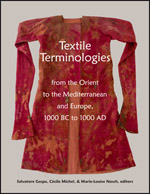Center, Textile Research

Textile Terminologies from the Orient to the Mediterranean and Europe, 1000 BC to 1000 AD
Date of this Version
2017
Document Type
Article
Citation
In Textile Terminologies from the Orient to the Mediterranean and Europe, 1000 BC to 1000 AD, ed. Salvatore Gaspa, Cécile Michel, & Marie-Louise Nosch (Lincoln, NE: Zea Books, 2017), pp. 500-519.
doi:10.13014/K2CC0XVN
Abstract
Byssus and sea-silk made of the fibre beard of the Pinna nobilis – zoologically called byssus – have both become subjects of scholarly interest in the last decade. The subject is discussed not only in scientific books and journals, but also in mass media around the world. Although scientific research has clarified some old misunderstandings, the double meaning of the term byssus has created new doubts and scepticism in the scholarly debate, bearing the danger of new, additional erroneous interpretations. This article recapitulates the present state of knowledge and calls attention to the consequences of assumed ‘old/new knowledge’ entering the scientific discussion.
The Oxford English Dictionary shows the following etymological entry for the term byssus:
< Latin byssus, < Greek βύσσος ‘a fine yellowish flax, and the linen made from it, but in later writers taken for cotton, also silk, which was supposed to be a kind of cotton’ (Liddell & Scott), < Hebrew būts, applied to ‘the finest and most precious stuffs, as worn by kings, priests, and persons of high rank or honour’ (Gesenius), translated in Bible of 1611 ‘fine linen’, < root *būts, Arabic bāḍ to be white, to surpass in whiteness. Originally therefore a fibre or fabric distinguished for its whiteness.
James Yates refers in his book Textrinum Antiquorum (1843) to Forster’s Liber singularis de bysso antiquorum of 1776. In Yates’ book vol. II about fibres of vegetal origin, in §70 titled Byssus, is discussed whether byssus is linen or cotton, especially in relation to Egyptian mummy bandages.
In the following I will examine the term byssus using the example of Egyptian mummy bandages based on antique written sources and material evidence.
Included in
Ancient History, Greek and Roman through Late Antiquity Commons, Art and Materials Conservation Commons, Classical Archaeology and Art History Commons, Classical Literature and Philology Commons, Fiber, Textile, and Weaving Arts Commons, Indo-European Linguistics and Philology Commons, Jewish Studies Commons, Museum Studies Commons, Near Eastern Languages and Societies Commons, Other History of Art, Architecture, and Archaeology Commons


Comments
Copyright © 2017 Salvatore Gaspa, Cécile Michel, & Marie-Louise Nosch. Photographs copyright as noted.